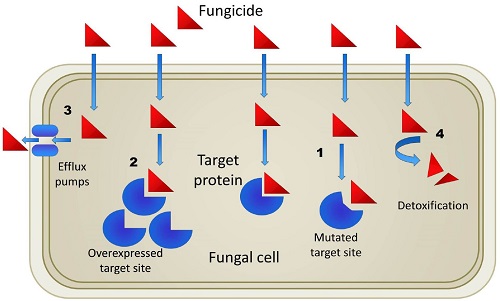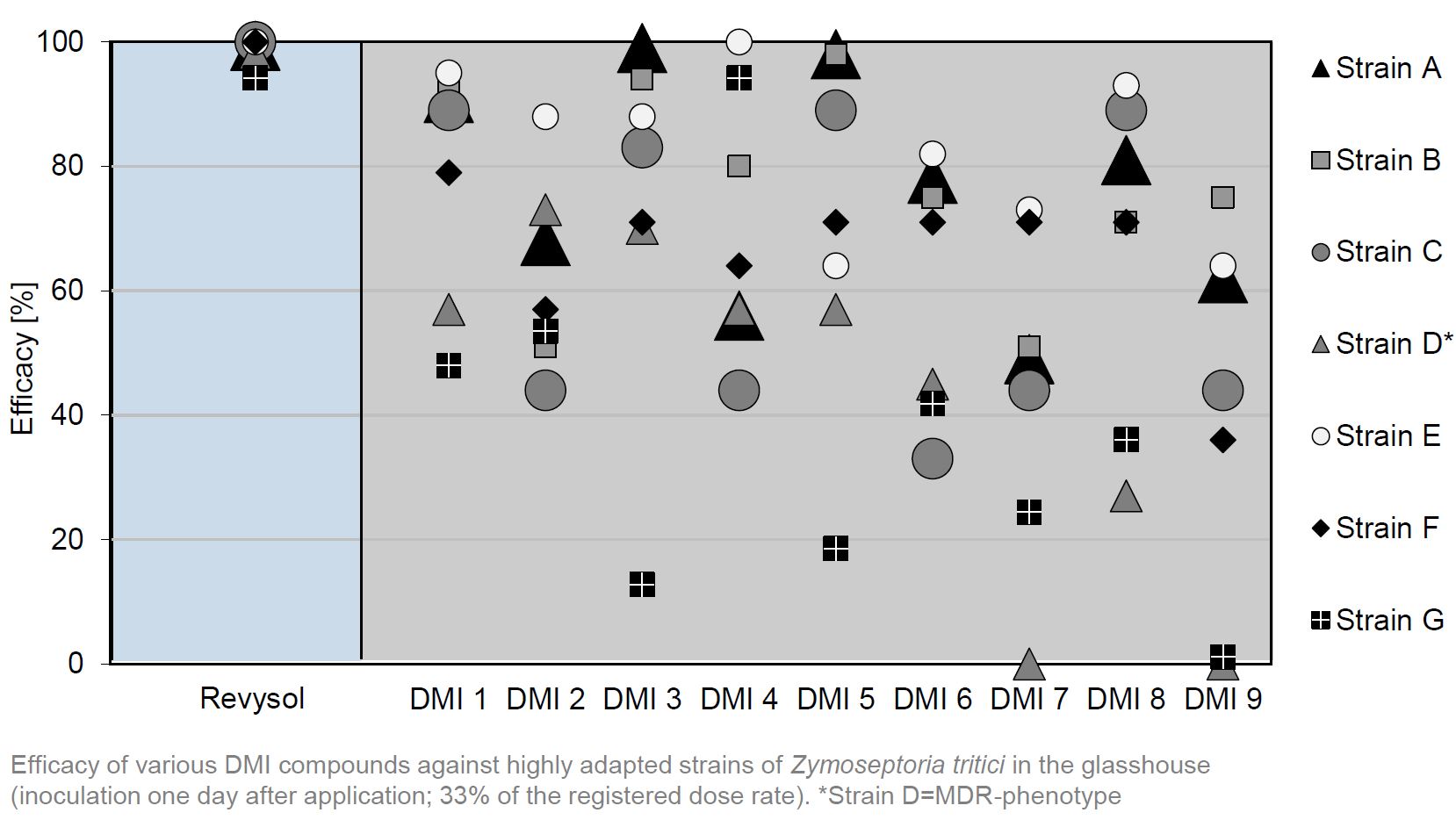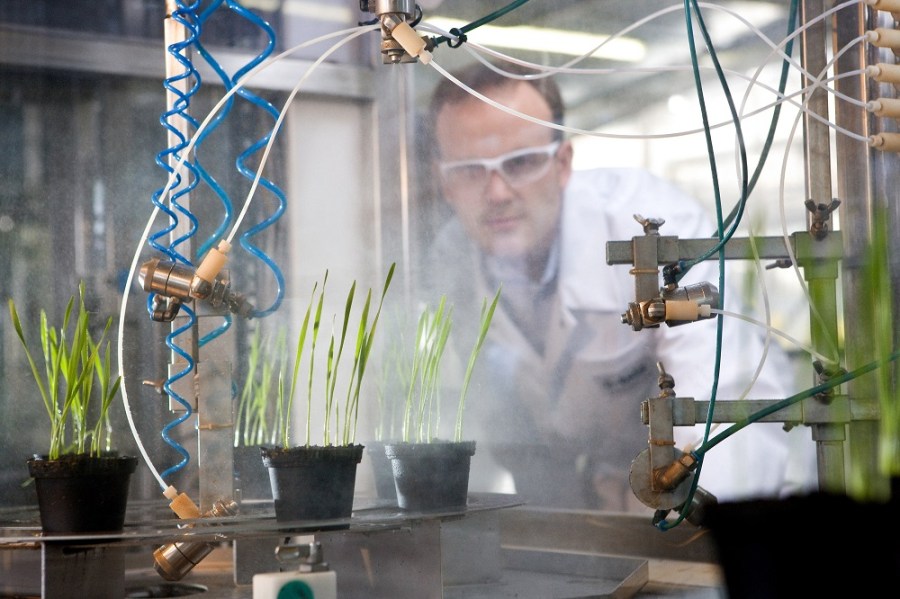They may have been with us for the past four decades, but the history of azoles is a remarkable story of innovation and success. CPM explores the surprises they may still hold in store.
They are curative, durable and have very interesting properties across a wide range of pathogens.
By Tom Allen-Stevens
“Do you have anything new up your sleeve?” The question, posed in 1977 by Prof John Lucas, who at the time was running the Crop Protection course at the University of Nottingham, was innocent enough.
Len Copping, who was leading a tour for the students of research facilities at what was then the Crop Protection Discovery facility at Boots, shrugged his shoulders. “There is this new coded material that shows some activity on mildew,” he said.
Widely used products
He was referring to prochloraz, that was one of the earliest azole fungicides introduced, and became, as Sportak, one of the most widely used products on commercial arable crops. “Azoles have been in practical use for more than 40 years, and yet they’ve retained their pivotal role in the fungicide armoury,” notes John Lucas.
“They are curative, durable and have very interesting properties across a wide range of pathogens. They still account for around 30% of global fungicide sales – more than any other fungicide class.”
But it may have been the resistance aspect that brought them to prominence in the early days. “Growers had MBC fungicides, so there was little perceived need for new chemistry. Then MBCs went down to resistance, just after prochloraz was launched , and interest switched to azoles in a big way. The whole chemistry has a common target site, but there’s a lot of variety in the properties of the various molecules.”
This target site is the 14α-sterol demethylase enzyme, commonly known as CYP51. John Lucas has worked on resistance mechanisms since the 1970s and believes that this is the key to the success of the chemistry.
“It’s proved to be an extremely effective target, as without a functioning CYP51, the growth of the pathogen is severely compromised. It’s also a highly conserved protein, so it can’t change that much without affecting its function. Whether by good chance or good judgement, it quickly became clear this was a very good target to inhibit, and this paved the way for a succession of azole fungicides, all with slightly different properties.”

Resistance to azoles began with mutations in the target site (1), while some isolates overexpress the CYP51 gene (2). Efflux pumps (3), enable the cell to expel the fungicide, while it can also detoxify the chemistry (4).
Reduced sensitivity
Throughout the 1980s and early 1990s, a large number of agricultural azoles were introduced onto the market. “The different ways the azoles behave has affected the way resistance has developed. It’s not true there’s no cross-resistance – there is. But within the reduced sensitivity shown by pathogens, there’s wide variation in the extent to which different azoles are affected,” he explains.
“So some mutations that cause resistance to tebuconazole actually increase sensitivity to prochloraz, for instance. In Zymoseptoria tritici, the early azole chemistry has become a lot less effective, but it’s been a gradual erosion, rather than a collapse. We now know a lot about how that has happened.”
The demethylation inhibitors (DMI) fungicides, which include the azoles, work by inhibiting the biosynthesis of the key CYP51 enzyme. Resistance to them began with mutations in the target site. These prevent the molecule from binding to it, illustrated in (1) in the diagram.
“Initially it was a simple story, but from the mid-1990s, there were further mutations, and these combined with the previous changes. You can now find some isolates with eight to ten multiple changes. Some of these mutations don’t directly affect resistance, but may help the protein to function in the presence of other changes,” says John Lucas.
It’s now a complex picture with a mixed population of isolates developing that have varying degrees of resistance, but some might be less fit and so are less competitive. “You do get highly resistant isolates, but so far they haven’t predominated. To a certain extent, that’s saved the azoles, which is why we see a gradual rather than complete breakdown in efficacy.”
Other resistance mechanisms exist, however. Some isolates overexpress the CYP51 gene, so provide more of the target site for the molecule to bind to (2). “It adds another increment, and if you have an isolate with mutations and overexpression, that puts resistance on a higher level. Fortunately, this is relatively rare, however.”
Another mechanism, known as efflux pumps (3), enables the cell to expel the fungicide, while it can also detoxify the chemistry (4). “These mechanisms have been shown to affect sensitivity in lab tests, and they’re not specific to a mode of action. But there’s less evidence that they’re contributing greatly to resistance in the field,” notes John Lucas.
“So there’s the potential nightmare of multiple mechanisms developing, and an evolutionary arms race taking place in the field. They now face even greater challenges with the new hazard-based regulatory system in Europe. But one encouraging aspect about azoles is their remarkable history of innovation and success. This is why the introduction of a new molecule in the class is particularly significant.”
BASF unveiled Revysol, its new “blockbuster” azole, in March 2016. It’s not due to hit the market until 2019, but there are high hopes for this new active. “I’d be very surprised if it didn’t have a few tricks up its sleeve. Septoria is the big issue, and it will need to prove itself against resistant isolates. But there are other diseases where current options are limited, such as fusarium, so it’ll be interesting to see how it fares.”
Efficacy of various DMI compounds

Highly adapted strains A to G of Zymoseptoria tritici were treated in the glasshouse with a 33% registered dose of ten DMI compounds, including Revysol and assessed one day after inoculation. *Strain D=MDR phenotype.
Source: BASF
Regulatory environment
But John Lucas has concerns about the regulatory environment into which it’ll be introduced. “One of the aspects that’s kept azoles so successful is the different properties they have. To limit the effect of resistance, we need as much diversity as possible, and if regulation limits the number of products on the market, that’ll put an extra strain on those that remain.”
Dr Rosie Bryson, team leader for arable crops fungicides at BASF, reveals the company also has high hopes for the new azole. “We’re excited, but we’re also worried. If it arrives and there’s nothing to protect it, it’ll come under huge pressure, especially if SDHIs have lost their efficacy.
“With Revysol, we’ve shown we can innovate, but increasingly we’re spending a lot of our resources conserving what we have, although if it wasn’t for the legislation, we may not have come up with a solution that’s as good as Revysol.”
All azoles are characterised by a triazole ring, and it’s this that does the binding to the target site. With Revysol, it sits on the neck of a slim isopropanol, which allows it to form a hook. This blocks the site of the enzyme and binds 100 times better than other azoles, according to BASF scientists.
“It’s this unique isopropanol moiety that seems to open the binding site, so potentially there’s less chance of mutations happening,” explains Rosie Bryson.
With pesticides facing new regulatory demands, BASF has taken a fresh approach to screening new chemistry. “It’s one reason why no new azoles have been launched in the last ten years. We’ve established a new screening method – a new active needs not just high activity but also no potential downsides that could prove a regulatory challenge.”
But it’s where Revysol sits in the resistance management story that may be of most interest. “In our tests, Revysol is controlling all strains of septoria. That’s very good control, not only of existing, shifted isolates, but includes those with overexpression and efflux pumps,” reveals Rosie Bryson (see chart on pxx).
Out in the field, this translates to noticeably improved performance. NIAB technical director Bill Clark has seen the chemistry perform in trials against prothioconazole where a single application of each azole was made at GS39. “We know that prothioconazole is giving good protectant activity, but it’s not such a good eradicant,” he notes.
“So in the trials, leaf 1 in both cases was clean. In the prothioconazole trial, there was septoria present on leaf 2. But in the Revysol plots, leaf 2 was also clean. This shows good eradicant activity has been restored.”
John Lucas feels such performance may just be the start, and that new technologies have a lot to offer this 40-year-old group of chemistry. “CYP51 has proved to be an excellent target, and we now have genomics and very elegant 3D modelling. So we can look in great detail at genetic variation and how different chemistry interacts with the protein.
“With gene editing, we can introduce mutations to see how they impact efficacy and understand more about resistance. We can use these technologies to revisit what we know about the old chemistry. We can understand better the mutations that exist in the population and how to configure mixtures to defeat them.
“But the real possibility here is that we can design resistance-busting azole molecules. No single compound will be the complete answer, but Revysol is a step in the right direction. And while the Holy Grail remains a novel mode of action, it’s clear we shouldn’t abandon the old friends yet.”
Persistent friend against the fungal foe
If there’s one cereal disease that’s shaped Jon Birchall’s farming career, it’s septoria. But throughout, there’s been one class of chemistry that’s always proven to be an effective weapon against it.
“Septoria has always been a problematic disease, but the introduction of azoles was a huge step forward, and probably the most significant addition to the fungicide arsenal. In the 1980s and 1990s, there was always new material coming forward, offering kickback and protection – it just didn’t seem to be an issue to control fungal diseases, and we managed to remain one step ahead,” he recalls.
His first experience of using azoles was in the mid-1980s, as farm manager on a large estate in Oxon. “Prochloraz and propiconazole were probably the earliest ones I used, alongside MBCs. There was also flutriafol that was so systemic it tinged the leaf tip and the whole field looked as though it had been scorched. But it was very effective.”
In those days, a two-spray programme was enough to protect a 10t/ha wheat crop. But by the early 2000s, Jon Birchall was adding in an ear spray. “I’d moved to the Kings Walden Estate at Hitchin, Herts, where we were growing milling wheats and needed to keep the ear clean. Tebuconazole was the product of choice.”
By the end of the decade, he’d moved to Shrewsbury, looking after around 1200ha of combinable crops for Balfours. “By then, the T0 spray was coming in,” he notes.
“Where we are in that part of the West is a rain shadow – we only get around 65cm. So we don’t suffer too much from rust, which is a distinct advantage for milling wheat. But septoria is very much a concern, and early in the season, you can always find some kicking about.”
With the triazoles becoming less effective against the disease, a little-and-often approach became the adopted practice. “In the early days, we’d apply a T0 on a case-by-case basis. But it’s now a routine part of the programme.”
For Jon Birchall, there are two azoles that stand out in the armoury. “Opus (epoxiconazole) was a game changer when it came in. The other one is prothioconazole. We’re heavily dependent on both.”
But they form part of a varied programme. He starts the season with a “cheap and cheerful” T0 spray, mixing chlorothalonil with cyproconazole and propiconazole. A straight SDHI is used at T1, mixed with epoxiconazole and folpet.
“My favoured flagleaf spray is Imtrex (fluxapyroxad) with Osiris P (epoxiconazole+ metconazole) – it’s priced well and is highly effective at keeping the flagleaf clean. At T3, prothioconazole is well regarded for keeping fusarium at bay, and I’d add in a strobilurin primarily for the greening.”
A key aspect of his programme is combining products, particularly those with a different mode of action. “When I started my career, no one had even heard of resistance. But it’s now essential to use a broad range of effective chemistry.”
And his favoured strategy includes five different azoles. “I do think it’s crucial we retain our ability to use a number of different products. If the current thinking on endocrine disrupters results in the removal of some of the triazoles, we’ll be in serious trouble. I’d happily accept tighter controls on the products we have than lose some from the armoury,” he says.
“But looking forward, I think the interesting aspect about Revysol is that it’s been created from day one on the premise of how it would operate against resistant septoria. It’s not just another triazole – it’s been selected intelligently.”
And he too believes this chemistry may have more to offer. “Strobilurins have been defeated, and SDHIs have a question mark over them. But azoles are still here and provide the basis for most spray programmes. I hope a resistance-busting azole is achievable, because if it was, it would be the best weapon we could have.”




